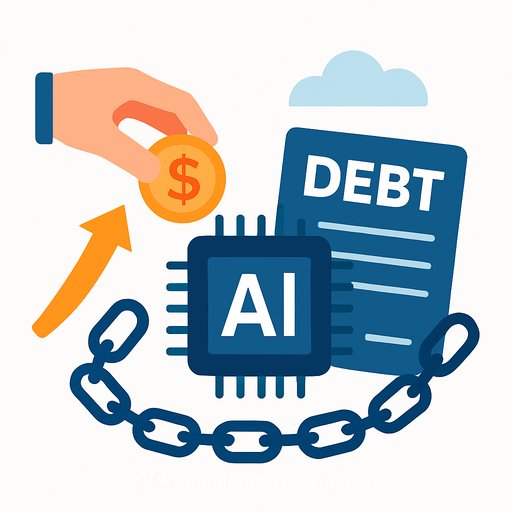Is AI a Bubble of Bubbles? What Finance Teams Should Do Now
A senior market analyst is calling today's AI trade the biggest bubble on record-17x larger than dotcom and 4x bigger than the subprime run-up before 2008. At the same time, private-market marks are stretching. One example making the rounds: reports putting OpenAI's valuation near $500 billion despite a thin profit record.
Bold calls make headlines. Your job is to separate signal from noise, manage risk, and position for both outcomes: a melt-up or a hard unwind.
What's the actual claim?
The note argues that years of artificially low rates drove capital into projects that won't pay back-what economists call misallocation. Using a Wicksellian differential lens, the analyst estimates misallocation near 65% of GDP today, versus roughly 18% ahead of the 2008 crash.
Translation: when the implied return on invested capital stays below the cost of money for long enough, you fund the wrong things. The bill eventually arrives.
Ground truth on AI productivity
- Enterprise pilots show mixed lift: task completion gains ranging from negligible to meaningful, but with poor repeatability over time.
- Adoption curves may be cooling among large firms, suggesting early enthusiasm is meeting integration friction and cost ceilings.
- Heavy users can cost more in compute than they pay in subscription fees. That's a unit economics red flag if it persists.
- If the next flagship model costs 10x more to train and run but barely improves outcomes, we hit diminishing returns hard.
Why this matters for capital allocators
Markets have priced in sweeping productivity gains and fat margins. If they don't materialize on time, the repricing can be sharp-especially in long-duration, high-multiple names and hardware tied to a single demand narrative.
On the other hand, if costs per token/parameter fall and real workflows compound, we could still see a prolonged capex cycle with steady cash flows to suppliers and infra.
Five risk flags to track
- Compute cost curve: Are training/inference costs falling faster than usage is rising?
- Model cadence vs. quality: Are 10x spend jumps delivering marginal gains?
- Unit economics: Ratio of heavy-user compute cost to ARPU; free-tier load vs. paid conversion.
- Enterprise adoption: Contracts shifting from pilots to multi-year rollouts-or stalling at POCs.
- Regulatory drag: Data, IP, and model liability rules increasing compliance costs.
Portfolio and planning playbook
- Barbell the exposure: Pair selective AI beneficiaries with cash-flow-generative hedges outside the AI theme.
- Favor cash returns: Prioritize firms with clear gross margin paths, pricing power, and declining COGS per inference.
- Pick-and-shovel discipline: Don't treat all suppliers the same; watch customer concentration and order visibility.
- Scenario test: Run 12-24 month cases for 30-50% lower AI-related revenue growth and higher capex, then check covenant headroom and runway.
- Valuation sanity checks: Cross-check EV/sales and EV/FCF against historic comp cycles (PC, mobile, cloud) and adjust required IRR.
What would confirm "bubble" dynamics
- Rising model costs with flat outcomes on core benchmarks and enterprise KPIs.
- Slowing net new enterprise seats and elongating sales cycles.
- Vendors subsidizing usage to defend share, compressing gross margins.
- Capex guidance cuts from hyperscalers or notable order pushouts in the supply chain.
What would disprove it (near term)
- Step-change cost declines (training and inference) outpacing usage growth.
- Repeatable productivity gains in key workflows (code, customer service, finance ops) with verifiable ROI.
- Stable or rising gross margins at AI-first vendors as paid usage scales.
- POCs converting to multi-year commitments across multiple industries.
Practical next steps for finance leaders
- Implement a gated AI spend policy: clear ROI hurdle, 90-day pilot, then scale or shut down.
- Track a monthly AI dashboard: cost per task, error rates, human rework time, and license utilization.
- Stress-test liquidity against a "zone 4" deflationary shock: revenue down, equity risk premia up, credit spreads wider.
- Re-underwrite top AI holdings: require a pathway to positive unit economics under conservative adoption curves.
- Diversify vendor risk: avoid single-model or single-cloud dependency in core workflows.
Bottom line
AI could deliver meaningful gains, but the market's pricing assumes speed and scale that are still unproven. Treat this as a high-beta theme with real optionality and real drawdown risk.
Manage exposure, demand hard ROI, and let the data-not the narrative-set your allocation.
If you're evaluating tools and skills for finance use cases, see curated options here: AI tools for finance.
Your membership also unlocks:






